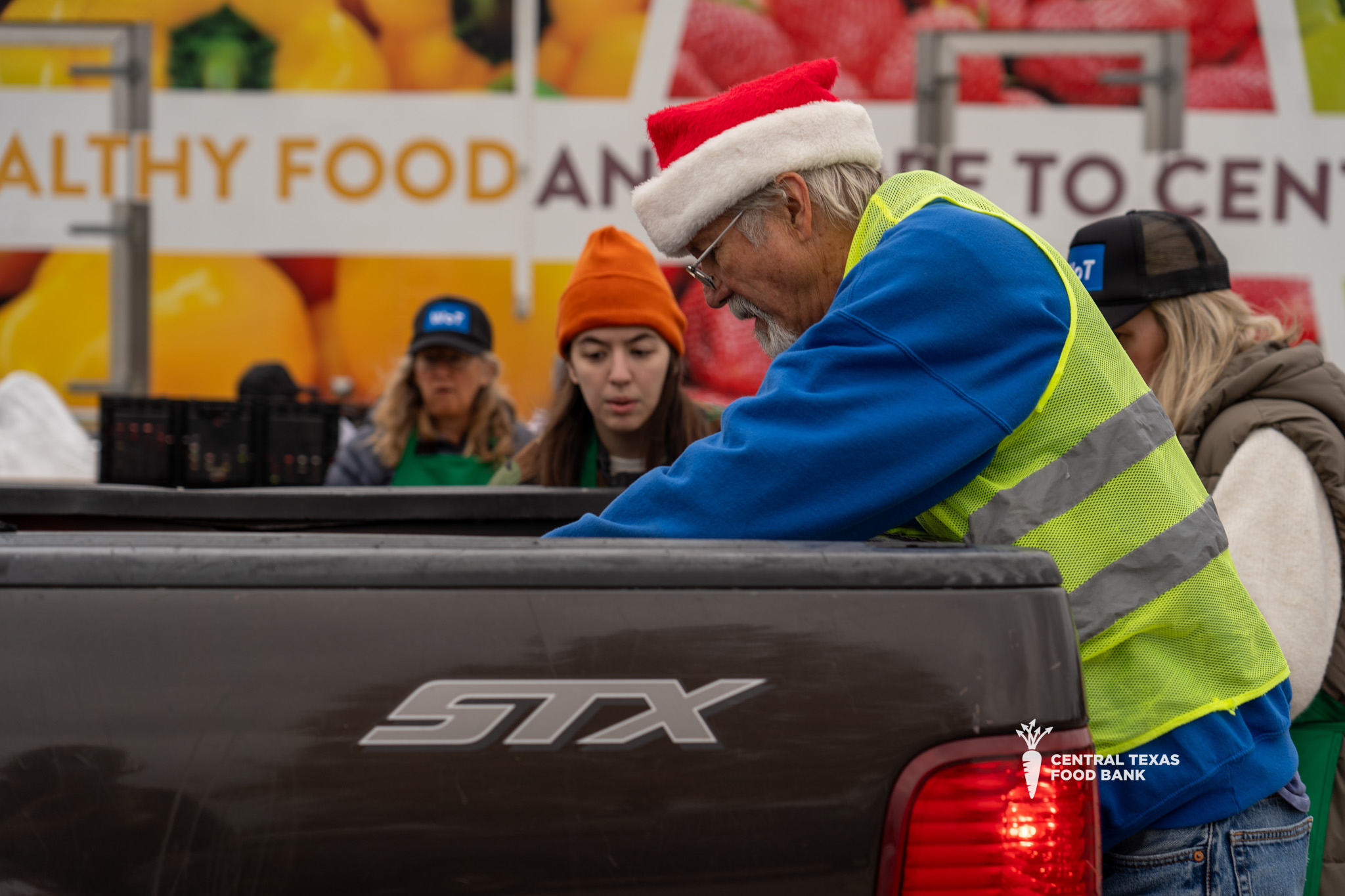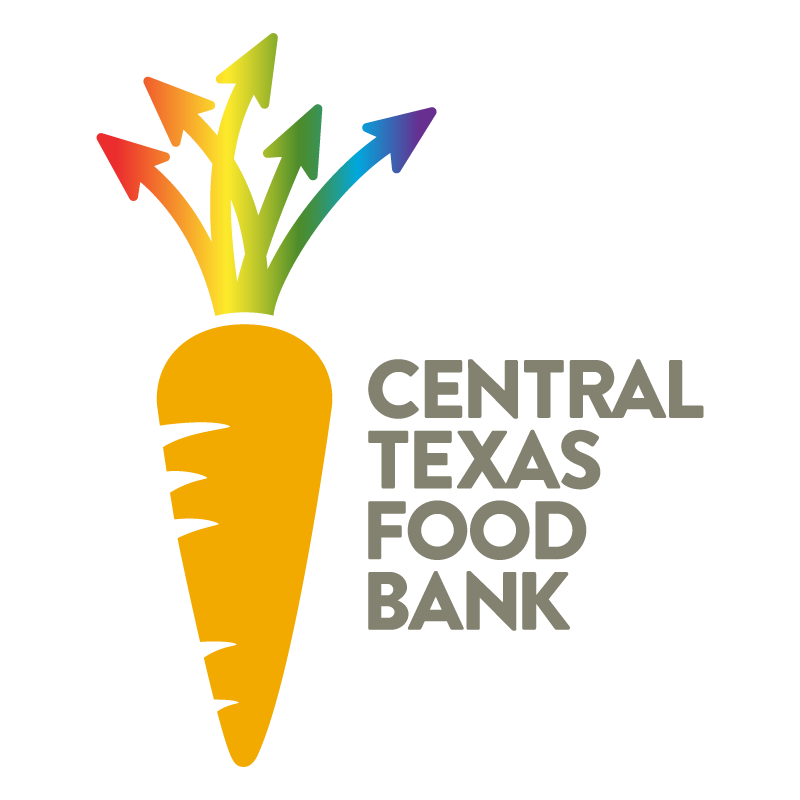
On a Tuesday morning at Dove Springs Recreation Center gym, a line starts forming early. Inside, volunteers are already moving with purpose: bagging produce, setting up tables, and making sure every neighbor who walks through the doors has the opportunity to choose the food that works best for their family.
This is one of Central Texas Food Bank’s (CTFB) mobile food pantry distributions, but it looks a little different from the large drive-through events you might picture. Here, neighbors walk through a market-style setup, pausing at each table to choose what makes sense for their families.

Don’t need watermelon this week? You can skip it. Prefer potatoes or greens instead? Those are on the table, too. After neighbors finish choosing their groceries, volunteers help carry the food to their cars, then circle back inside to walk with the next person in line.
It’s a more personal kind of distribution, full of small conversations, familiar faces, and quiet moments of care. For volunteers like Trey Oprendek and David Johns, it’s become much more than just a way to give back. It’s where a new kind of community has taken root.
Stepping In During Uncertain Times
Both Trey and Dave found their way to CTFB at a moment of transition.
“I retired in 2019 and then didn’t have a lot to do during COVID,” Trey said. “Once things started opening up, I needed to do something. I’d always seen the food bank and the volunteers, and it just caught my interest.”
He signed up for mobile food pantry shifts, including the large-scale distributions at the Travis County Exposition Center, and never really stopped. Over time, he and his wife also volunteered with CTFB’s Home Delivery program, helping get groceries directly to neighbors who can’t easily access a food pantry.
Dave’s story began in a similar way.
“I retired in March of 2020, right as COVID hit the fan,” he said. “Everything I wanted to do was shut down. I started seeing information about the food pantries. Food is very communal, and the events were held outside. I thought, ‘Well, this could work.’ I’ve been doing it ever since the summer of 2020.”
What began as a safe way to be helpful during the pandemic has grown into a lasting commitment to their community.
Seeing Central Texas Through a New Lens
Like many Central Texans, both Trey and Dave were aware that some neighbors face hunger, but the scale of the need didn’t fully come into focus until they were standing in the middle of a distribution.
“You think of Austin and Central Texas as a very affluent area,” Trey said. “Then you go to places like Dove Springs or Onion Creek, Pflugerville, Nelson Field, and you see the number of people who have a need. It’s a complete shift in your mindset.”
For Dave, that realization hit at those early pandemic distributions.
“It was very sobering to see so many hundreds of people at each event who need food,” he said. “You’re aware of it in theory, but not how deep that need is until you’re right there helping.”
At Dove Springs, that need is met with choice and dignity. Tables are lined with fresh produce, pantry staples, and refrigerated items that can help anchor a full week of meals. Neighbors can select what works best for their families, whether they’re vegetarian, managing health conditions, or simply trying to stretch their grocery budgets.
“If someone doesn’t want more squash, or they don’t eat meat, they don’t have to take it,” Dave said. “It means the food doesn’t go to waste, and people get what they’ll actually use.”
For Trey, seeing neighbors pick up nutritious options is a meaningful part of the work.
“People get produce, and it helps them with nutrition,” he said. “They learn what’s good to eat. I haven’t quite learned that lesson myself yet — but I’m working on it,” he added with a laugh.
A Different Kind of Community
While both men came to CTFB to support their neighbors, they found something else as well: the unexpected gift of friendship.
“I think that’s one of the things I enjoy most about the mobile food pantries,” Trey said. “You meet so many different people. Sometimes companies come out. Sometimes it’s a civic group. But there’s also a core group of people who are here all the time. You get to talking, and next thing you know, you’re having lunch together.”

Over time, that rhythm grows into its own kind of community.
“You look forward to seeing people on days you’re volunteering,” Trey said. “You know your friends will be there.”
Dave echoed that sentiment.
“There are a lot of like-minded people here,” he said. “You come in and you know Peter, you know Trey, you know Jaelene, you know Stephanie. You already have a sense of how the day will go. It makes it easy to divide up tasks and adjust if something’s different that day. We’re glad to help the folks organizing the distribution and make their jobs a little easier.”
That sense of ease and familiarity doesn’t just benefit long-time volunteers — it makes a difference for first-timers, too. When new volunteers arrive, they’re greeted by a group that knows the flow and is ready to welcome them in.
“You always want to be welcoming and inclusive of the people who are coming,” Trey said.
The Little Moments That Matter
For Trey and Dave, some of the most meaningful parts of volunteering are the small, everyday interactions that don’t always make it into photos.
“There’s a sincere appreciation from the people who come through,” Trey said. “It’s not just what they say, it’s how they act. You can see it on their faces. Honestly, you get so much more out of it than they do.”
And then there are the lighter moments, the ones that remind us that food distributions are about being human together, not just moving boxes.
“You get to know some of the people who come through the line, especially the ones with dogs,” Trey said. “It’s really fun to see them. Last week, there was a big golden retriever named Polar Bear, and there’s another dog named Jinx. They’re all characters. You look forward to seeing them.”
Even the extra effort of walking groceries out to cars becomes part of the experience.
“It’s more work than a drive-up, because you’re taking carts all the way out and back,” Dave said. “But some folks are counting their steps and volunteering to push carts because they ‘need to get their steps in.’ It works well for everybody.”
“It’s Not Rocket Science — Just Jump In”
When asked what they’d say to someone who’s nervous about volunteering for the first time, both Trey and Dave offered the same reassurance: you don’t have to have it all figured out before you arrive.
“First of all, don’t be nervous,” Trey said. “Find the Central Texas Food Bank person who’s leading the distribution and ask what you can do to help. Next thing you know, the distribution’s over. It goes so fast. You’re busy the whole time. Don’t hesitate — it’s a really fun experience.”

Dave agrees.
“We’ve had a number of people come out for the first time who are uncertain about how it’s going to go,” he said. “But once you do the first few, you see how it works. It’s not rocket science. Almost everybody can just jump in and go, ‘Okay, I see how this works.’ You all make it easy.”
For Trey and Dave, volunteering with CTFB has become more than a way to spend a morning each month. It’s where they witness neighbors supporting neighbors, where they see both the need and the generosity in Central Texas, and where they’ve built a new circle of friends along the way.
In a community as large and rapidly growing as ours, that kind of connection matters. And at Dove Springs Rec Center, it all begins the same way, week after week: tables full of fresh food and volunteers ready to say, "We’re glad you’re here."
Inspired by Trey and Dave’s stories?
You can be part of this work, too. Whether you come alone, bring a friend, or show up for the first time not knowing what to expect, our team and volunteers will welcome you and guide you every step of the way. Every shift helps ensure children, families, and older adults across Central Texas have access to the nutritious food they need.
Click here to sign up to volunteer and join a community built on compassion, connection, and care for our neighbors.






